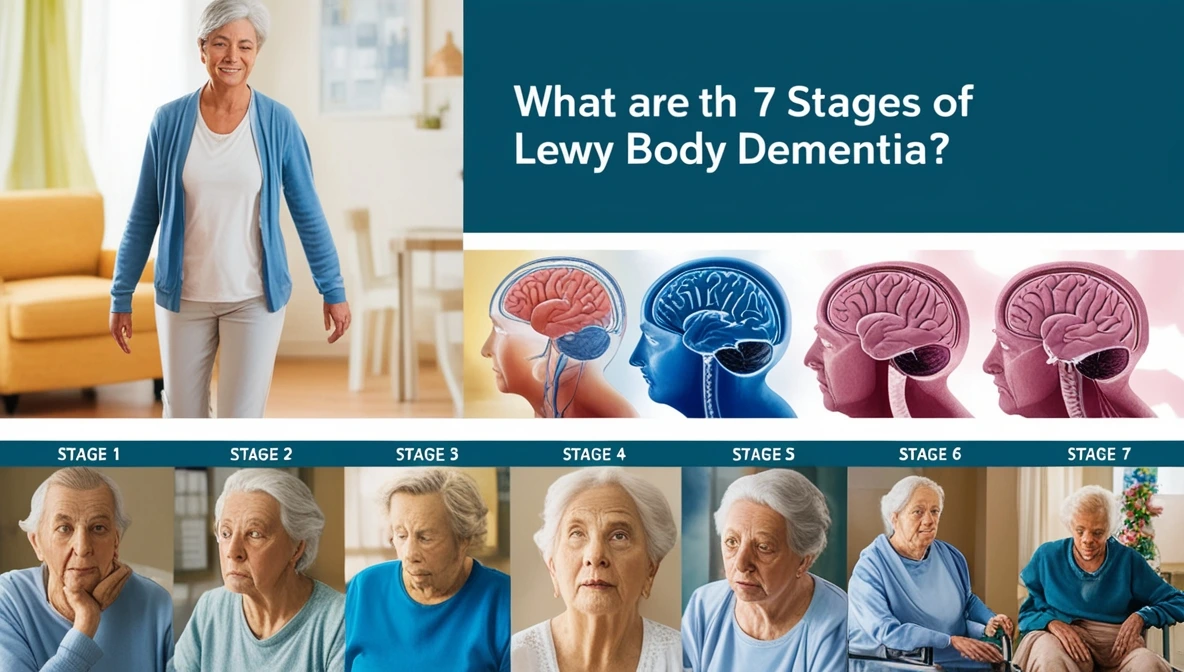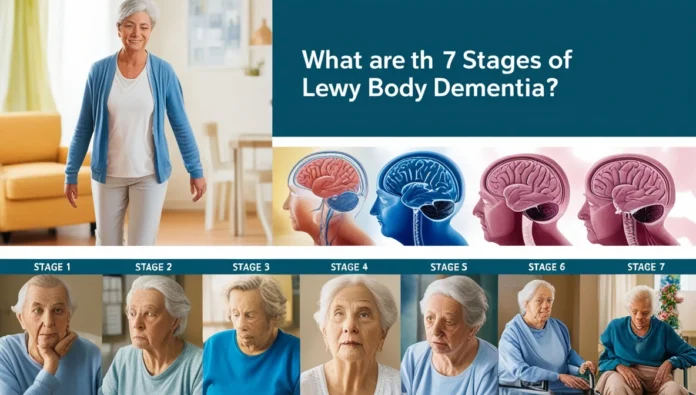7 Stages of Lewy Body Dementia (LBD) is a complex neurological disorder that affects cognitive function, motor skills, and mental health. Understanding the stages of Lewy Body Dementia can help caregivers and loved ones provide better support as the disease progresses. In this article, we’ll explore the 7 Stages of Lewy Body Dementia to give you a clear view of what to expect during each phase.
Table of Contents
ToggleKey Points about the 7 Stages of Lewy Body Dementia:
- Subcategory of Dementia: Lewy Body Dementia (LBD) is a subcategory of dementia, involving memory impairment, cognitive decline, and difficulty in decision-making that affects daily life.
- One of the Most Common Forms: LBD is among the most prevalent forms of dementia, making it a significant concern in neurodegenerative disorders.
- Progression in Stages: Like other forms of dementia, LBD has different stages of severity, which assist doctors in diagnosing and formulating treatment plans.
- Seven Stages: The disease progresses through seven stages, each with specific symptoms and challenges for patients and caregivers.
- Response to Symptoms: Understanding the symptoms at each stage helps patients and family members respond more effectively, ensuring better care and support as the disease advances.

Key Points about Lewy Body Dementia (LBD):
- Second-Most Common Dementia: LBD is the second-most common form of dementia after Alzheimer’s disease, but it uniquely affects cognitive functioning more than other types.
- Cognitive Decline Due to Lewy Bodies: The presence of abnormal protein deposits, known as Lewy bodies, primarily composed of alpha-synuclein, causes significant cognitive decline in LBD patients.
- Difference from Alzheimer’s and Parkinson’s: While Alzheimer’s leads to memory issues through beta-amyloid clumps and tau protein tangles, and Parkinson’s primarily affects motor function, LBD impacts both cognitive and motor functions due to alpha-synuclein deposits.
- Alpha-Synuclein vs. Tau Proteins: Although LBD patients may also develop tau protein tangles, the buildup of alpha-synuclein is the key characteristic that differentiates LBD from Alzheimer’s and Parkinson’s.
- Broader Range of Symptoms: The neurochemical differences in LBD result in a broader range of symptoms than in Alzheimer’s or Parkinson’s, making the disease progress more rapidly.
- Shorter Survival Rate: Studies show that people with LBD typically survive only five to eight years after symptoms first appear
LBD Symptoms and Risk Factors: A Comprehensive Overview
Lewy Body Dementia (LBD) affects many aspects of mental, physical, and behavioral health, making everyday tasks challenging. Below are the key symptoms and risk factors associated with LBD, providing valuable insights for patients and caregivers.
1. Cognitive Decline
LBD patients often experience a noticeable decline in cognitive abilities, similar to Alzheimer’s disease. This includes memory loss, confusion, disorientation, and difficulty with problem-solving. Tasks that were once simple may become increasingly complex, affecting day-to-day life.
2. Motor Impairment
Movement-related symptoms in LBD resemble those of Parkinson’s disease. Patients may experience slowed reaction times, muscle stiffness, tremors, and impaired hand-eye coordination. A characteristic “shuffling walk” is common, making mobility more difficult and increasing the risk of falls.
3. Autonomic Nervous System Dysfunction
LBD affects the autonomic nervous system, leading to deregulation of essential body functions. This may result in irregular heart rate, blood pressure fluctuations, digestive issues, bowel control problems, and excessive sweating. These symptoms can significantly affect the quality of life and require medical intervention.
4. Visual and Auditory Hallucinations
Hallucinations are a hallmark of LBD. Patients may see, hear, or feel things that aren’t there, such as people, animals, or unfamiliar shapes. These vivid hallucinations can be distressing, not only for the patient but also for family members.
5. Sleep Disorders
Rapid Eye Movement (REM) sleep behavior disorder is commonly associated with LBD. This causes patients to act out their dreams, move, or speak during sleep. They may also have difficulty achieving deep, restful sleep, leading to fatigue and daytime sleepiness.
6. Risk Factors
LBD typically affects older adults aged 65 and above, with a family history of dementia being a key risk factor. Studies suggest that 1 in 10 older Americans has been clinically diagnosed with dementia, while 22% experience mild cognitive impairment, putting them at increased risk of developing LBD.
Understanding the symptoms and risk factors of Lewy Body Dementia is crucial for early diagnosis and management. With its blend of cognitive, motor, and behavioral symptoms, LBD presents unique challenges, but early intervention and proper care can help improve the quality of life for those affected.
What Are the 7 Stages of Lewy Body Dementia?
Lewy body dementia (LBD) is typically diagnosed through brain scans or detailed memory tests, which help determine the severity of the disease. While many patients are diagnosed in the early stages, some cases go undetected until the symptoms become moderate or severe. The progression of LBD is divided into seven stages, providing a structured understanding of the disease’s impact, which aids medical professionals and caregivers in managing treatment and care effectively.

1. No Impairment (Stage 1)
At this initial stage, individuals show no noticeable symptoms of cognitive decline or motor issues. This phase is often undetected because people continue their normal activities without visible problems. However, the Lewy bodies (protein deposits) that cause dementia have already begun accumulating in the brain.
2. Very Mild Cognitive Decline (Stage 2)
In this stage, individuals may experience slight forgetfulness, often attributed to normal aging. Simple tasks like remembering names or recalling recent events might take longer. Symptoms are still subtle, and many people remain independent during this period.
3. Mild Cognitive Decline (Stage 3)
Stage 3 marks the onset of more noticeable symptoms, such as difficulty concentrating and organizing tasks. Memory problems become more evident, and patients may struggle with daily routines. At this stage, mild movement issues, such as stiffness or slow walking, may also appear, but they are not severe enough to cause significant concern.
4. Moderate Cognitive Decline (Stage 4)
At this point, individuals with Lewy Body Dementia require more assistance with day-to-day activities. Memory loss becomes more pronounced, and confusion about time or place is common. Motor symptoms like tremors or muscle rigidity may start to impact mobility. Caregivers may need to step in to help with tasks like cooking, managing finances, or driving.
5. Moderately Severe Cognitive Decline (Stage 5)
Stage 5 is characterized by an increased need for assistance in personal care and daily functions. Individuals may struggle with dressing, bathing, and other basic tasks. Hallucinations and delusions become more frequent, and patients often require around-the-clock supervision. Mobility is significantly affected, and falls become a greater risk.
6. Severe Cognitive Decline (Stage 6)
During Stage 6, memory loss worsens, and individuals may forget the names of close family members or become confused about their surroundings. Communication becomes difficult, and speech may become slurred. Physical symptoms, such as muscle stiffness and tremors, worsen, limiting the person’s ability to walk or sit without assistance. Full-time care is often required as both cognitive and physical abilities continue to decline.
7. Very Severe Cognitive Decline (Stage 7)
The final stage of Lewy Body Dementia involves near-total dependence on caregivers. Individuals lose the ability to speak and respond to their environment. Swallowing difficulties are common, leading to challenges in eating and drinking. Mobility is usually lost, and the person may spend most of their time in bed. End-of-life care becomes essential as the body shuts down.
Raising Awareness of Lewy Body Dementia
Although Lewy body dementia is the second-most common type of this progressive disease, Alzheimer’s and Parkinson’s get more public attention. Use this information to raise awareness of the symptoms and stages of LBD. You could help someone get an early diagnosis and give them more time with loved ones.
Conclusion
Understanding the 7 stages of Lewy Body Dementia is crucial for providing the right level of care at each phase. As the disease progresses, the needs of the individual will change, requiring more support from caregivers and medical professionals. Early diagnosis and intervention can help manage symptoms and improve quality of life for both the patient and their loved ones.
FAQs
How long can you live with 7 stages of Lewy Body Dementia?
The life expectancy for individuals with Lewy Body Dementia (LBD) typically ranges from five to eight years after the onset of symptoms, although this can vary based on individual health and care circumstances.
What are the end stages of Lewy body dementia?
In the end stages of Lewy body dementia, individuals experience near-total dependence on caregivers, loss of speech, and severe mobility issues. They may also suffer from significant cognitive decline and require full-time care.
What is the dying process with Lewy Body Dementia?
The dying process in lewy body dementia may involve complications from other health issues, such as infections. Patients may exhibit changes in consciousness, increased fatigue, and a gradual decline in physical abilities as they approach the end of life.




